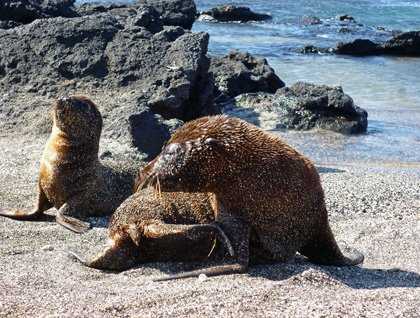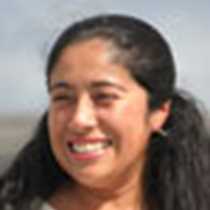After a long northbound navigation around the island of Isabela, the National Geographic Endeavour entered the western part of the Galapagos Archipelago. The cold waters of the Equatorial Counter-current rise up along the edge of the Galapagos Platform, bringing to the surface not only cool sea temperatures but also an extraordinary amount of plankton, creating great conditions for marine wildlife. This morning before breakfast, there was an announcement of Tropical Whale sightings! This species, also known as “Brydes” whales, are elusive and were busy fishing, but we counted more than four! What a great way to start our day!
We dropped anchor at Fernandina Island. It was a nice sunny morning with a clear blue sky, and Fernandina Island, the world’s largest pristine island in the world, the youngest of the Archipelago, was awaiting us. Over the innumerable lava flows, which at first sight seems lifeless, we noticed a large number of marine iguanas lying basking in the sun, hugging each other to warm up. These unique animals are found only in the Galapagos, and they are so tame that they ignore us, and we were able to get very close and capture some amazing photographs. It is so hard to see them among the dark rocks that we had to walk very cautiously to avoid stepping on them. This scene was so picturesque, with the colorful sally lightfoot crabs standing out brilliantly against the dark rocks. Not too far away, under the shade of a mangrove tree, a female sea lion was lying with her newborn, the placenta was still at one side, and the cries of the baby sea lion and the tenderness between the mother and her pup was an unforgettable scene to witness. Along the shore, we encountered several playful sea lion pups, which always seem to pose for the cameras. During the walk, we were fortunate to see a pair of flightless cormorants; the male was very busy looking for nesting material, going into the water and coming back with sea weed, while the female cormorant placed the materials in the right position. This is truly an amazing place, and we left with memories that will last forever!
Once everybody was onboard, we pulled the anchor and sailed towards Isabela Island, our course set to Ecuador Volcano. We take advantage of our time onboard to host some excellent lectures, and after a well-deserved lunch, we also offered a very interesting workshop led by one of the members of our Natural History Staff, Gaby Bohorquez, who explained how to convert paper into pearls! Her talk and instructions put all of the participants into action, and they were cutting paper, rolling it, converting them in pieces of art, which later on, will be handed to the local artisans who can make money selling the jewelry. On board the National Geographic Endeavour, our guests not only learn about natural science, but also about conservation in action.
We dropped anchor at the southern end of the caldera of Ecuador Volcano, an area called Punta Vicente Roca. The first activity of the afternoon was snorkeling. The cool waters in this region offer a unique experience, and we encountered sea turtles, sea lions, flightless cormorants, Galapagos penguins and lots of fish. The visibility was excellent and the water was uncharacteristically warm waters for this area: 73 degrees F! Afterwards, we came back to explore the coastline from the Zodiacs, with cameras in hand. It was a wonderful outing with excellent sightings: Galapagos penguins, sea lions, green sea turtles showing their heads, flightless cormorants drying the feathers of their tiny wings, great weather conditions, and wonderful light.
With the last beams of sun, the National Geographic Endeavour moved north across the Equator. It was a beautiful sunset, our guests enjoyed a wine degustation while we crossed “the line” into the northern hemisphere. Most of our guests decided to cross the Equator line in a very literal way, as we were holding a symbolic rope equator across the bow. Exploration is a serious affair, but it is nice to add some humor from time to time. Every day in Galapagos is an amazing day, and tomorrow the adventure is to be continued…







